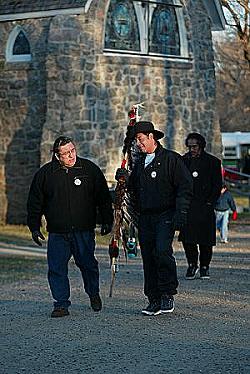|
In
1862 bounties were placed on the scalps of Dakota
people by Governor Alexander Ramsey which
eventually reached $200
|
History
On
November 7, 2014, as in every second year since
2002, Dakota people from the United States and
Canada will begin a 150-mile long Commemorative March
through southern Minnesota in honor of their ancestors
who were forcibly removed from the Lower Sioux Agency
to concentration camps at Mankato and Fort Snelling
in November of 1862. For the Dakota this commemoration
signifies an opportunity to remember and grieve for
the suffering endured by their ancestors as well as
to relate a perspective of the event which has rarely
been told.
On November 7, 1862, a group of about
1,700 Dakota, primarily women, children and elderly,
were force-marched in a four-mile long procession from
the Lower Sioux Agency to a concentration camp at Fort
Snelling. Two days later, after being tried and convicted,
over 300 condemned men who were awaiting news of their
execution were placed in wagons while they were shackled
and then transported to a concentration camp in Mankato,
Minnesota.
Both
groups had surrendered to the United States army at
the end of the U.S.-Dakota War of 1862, believing they
would be treated humanely as prisoners of war. Instead,
the men were separated out and tried as war criminals
by a five-man military tribunal. As many as forty cases
were tried in a single day, some taking as little as
five minutes. Upon completion of the trials, 307 men
were condemned to death and 16 were given prison sentences.
The remaining Dakota people, primarily women, children,
and elderly were then forced to endure brutal conditions
as they were forcibly marched to Fort Snelling and then
imprisoned in Minnesota's first concentration camp through
a difficult winter.
As
both groups were paraded through Minnesota towns on
their way to the camps, white citizens of Minnesota
lined the streets to taunt and assault the defenseless
Dakota. Poignant and painful oral historical accounts
detail the abuses suffered by Dakota people on these
journeys. In addition to suffering cold, hunger, and
sickness, the Dakota also endured having rotten food,
rocks, sticks and even boiling water thrown at them.
An unknown number of men, women and children died along
the way from beatings and other assaults perpetrated
by both soldiery and citizens. Dakota people of today
still do not know what became of their bodies.
After
38 of the condemned men were hanged the day after Christmas
in 1862 in what remains the largest mass hanging in
United States history, the other prisoners continued
to suffer in the concentration camps through the winter
of 1862-63. In late April of 1863 the remaining condemned
men, along with the survivors of the Fort Snelling concentration
camp, were forcibly removed from their beloved homeland
in May of 1863. They were placed on boats which transported
the men from Mankato to Davenport, Iowa where they were
imprisoned for an additional three years. Those from
Fort Snelling were shipped down the Mississippi River
to St. Louis and then up the Missouri River to the Crow
Creek Reservation in South Dakota. A memorial to some
of those people was dedicated at Crow Creek in 2001.

The
memorial at Crow Creek
This
ethnic cleansing of Dakota people from Minnesota was
one part of the fulfillment of a larger policy of genocide.
Governor Alexander Ramsey had declared on September
9, 1862 that "The Sioux Indians of Minnesota must be
exterminated or driven forever beyond the borders of
the state." The treatment of Dakota people, including
the hanging in Mankato and the forced removal of Dakota
people from Minnesota, were the first phases of Ramsey's
plan. His plan was further implemented when bounties
were placed on the scalps of Dakota people which eventually
reached $200. Punitive expeditions were then sent out
over the next few years to hunt down those Dakota who
had not surrendered and to ensure they would not return.
These actions cleared the way for white settlement of
Minnesota.
While
small numbers of Dakota people began trickling back
to their homeland by the late 1880s, most Dakota people
remain in exile from their ancient homeland. This Commemorative
March is a reason for Dakota people to not only honor
their ancestors by acknowledging the suffering they
endured, it is also a chance to tell the truth about
Minnesota's shameful ethnic cleansing of its Indigenous
people and an opportunity for Dakota reconciliation
in their homeland of Minnesota Makoce (Land Where the
Waters Reflect the Skies) 140 years later.

In
2002 Ron Leith who is the carrier of the Eagle staff
for the 38 hanged at Mankato helped with our opening
ceremonies. He asked Gerald Standing who is from the
Wahpeton Reserve in Saskatchewan, to take care of the
staff for the march, so Gerald started them out every
morning carrying the eagle staff and ended with it every
day. Gerald put in a lot of miles on the march, walking
every day even when it was very painful. The picture
below was taken on the first morning of the march as
they were leaving Lower Sioux.

The
marchers leaving the Lower Sioux in 2002
Leo
Omani, from the Wahpeton Reserve in Prince Albert, Saskatchewan.
was with the group for the entire march and it was his
little red car that served them as the lead car for
us the entire way (he and Gerald Standing took turns
driving it). Leo was also the person who conceived of
the idea for a commemorative event to honor the group
of primarily women and children who made the march in
1862. The picture below is of him taken the morning
they left Lower Sioux on the first day.

Leo
Omani